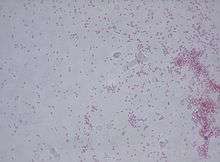Enterobacter aerogenes
Enterobacter aerogenes est une bactérie Gram négative, oxydase -, catalase +, citrate +, indole -. C'est un bacille, de 1 à 3 microns de longueur, qui peut se déplacer grâce à un flagelle[1].

Cette bactérie peut être responsable d'infections nosocomiales, et peut causer des infections opportunistes. La plupart de ces infections sont sensibles aux antibiotiques. Cette bactérie possède néanmoins des mécanismes de défense aux antibiotiques, notamment Bêta-lactamase, et peut donc devenir rapidement résistante aux antibiotiques standards au cours du traitement. Pour éviter d'empirer l'infection, il peut être nécessaire de changer d'antibiotiques.
Résultats à des tests d'identification biochimiques[2]
| Méthode d'identification | Résultat du test |
|---|---|
| Mobilité | Positif |
| Indole | Négatif |
| Rouge de méthyle | Négatif |
| VP | Positif |
| Citrate de Simmons | Positif |
| Nitrate réductase | Positif |
| H2S | Négatif |
| Hydrolyse de l'urée | Négatif |
| Oxydase | Négatif |
| Catalase | Positif |
| Fermentation du Glucose | Positif |
| Fermentation du Lactose | Positif |
| Fermentation du Saccharose | Positif |
| Fermentation du Maltose | Positif |
| Arginine dihydrolase | Négatif |
| Ornithine décarboxylase | Positif |
| Lysine décarboxylase | Positif |
| Hydrolyse de la gélatine | Négatif |
Références
- (en) W. E. Sanders et C. C. Sanders, « Enterobacter spp.: pathogens poised to flourish at the turn of the century. », Clinical Microbiology Reviews, vol. 10, no 2, , p. 220–241 (ISSN 0893-8512 et 1098-6618, PMID 9105752, lire en ligne)
- J J Farmer, B R Davis, F W Hickman-Brenner et A McWhorter, « Biochemical identification of new species and biogroups of Enterobacteriaceae isolated from clinical specimens. », Journal of Clinical Microbiology, vol. 21, no 1, , p. 46–76 (ISSN 0095-1137, PMID 3881471, lire en ligne)
- Portail de la microbiologie
This article is issued from
Wikipedia.
The text is licensed under Creative Commons - Attribution - Sharealike.
Additional terms may apply for the media files.